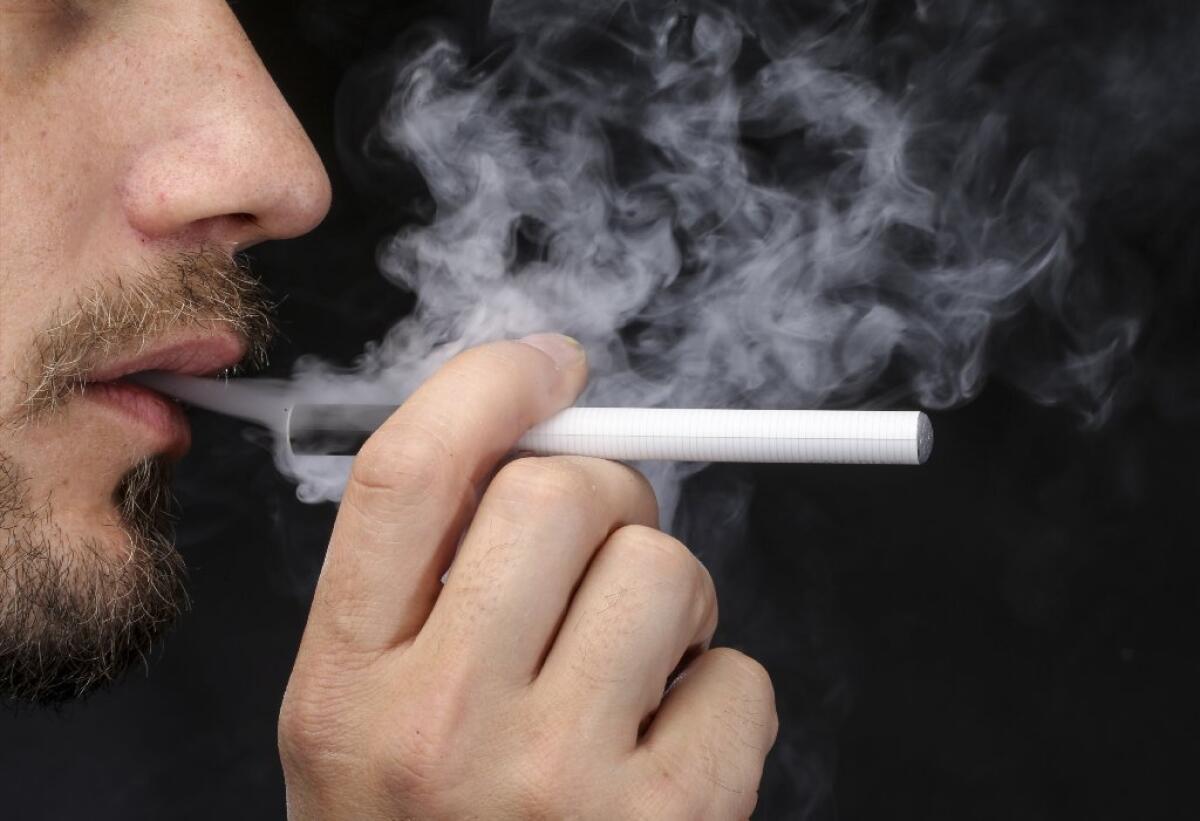Vaping dilemma: Do e-cigarettes’ benefits for smokers outweigh the risks to teens?

Some basic questions about e-cigarettes and other vaping devices will have to be answered as the FDA acts to regulate the booming industry for the first time.
E-cigarettes help smokers cut back on or kick their deadly habit — or they feed the addiction. They act as a gateway to smoking with seductive flavorings and safety claims — or they divert a generation of would-be smokers from the dangers of burned tobacco.
They reduce nonsmokers’ involuntary exposure to secondhand smoke — or replace it with different toxins. They expose curious children to nicotine cartridges that can prove fatal if ingested — or they’re no more dangerous than laundry pods, which remain on the market.
They are a danger to the public’s health. They are boon to the public’s health.
When it comes to assessing the impact of electronic cigarettes on Americans’ health, a regulatory responsibility the Food and Drug Administration claimed on Thursday, only one thing is clear through the vapor: The health effects of these smokeless nicotine-delivery devices on the broad population are a matter of heated dispute.
The research that will be needed to guide the FDA’s deliberations has produced equally mixed findings. And it is racing to keep up with a $7.3-billion global market that is expanding and pumping out new products at an explosive pace.
As the FDA reviews the applications of e-cigarette marketers, they are very likely to find evidence of unambiguous harm, said tobacco researcher Rebecca Williams of the University of North Carolina’s Lineberger Comprehensive Cancer Center.
Hundreds of brands, and a growing array of products, are available to U.S. consumers, and none to date has been subject to any oversight, said Williams. Their manufacturers, many of them outside the United States, need adhere to no production standards. They have not been required to disclose their ingredients, nor to prove that they are safe, she added.
Some use flavorings found safe to ingest but demonstrably dangerous to heat and inhale, said Williams. There are mounting reports of vaping devices exploding and catching fire, she added.
But these are likely to be the easy cases.
Over the coming years, experts said, FDA regulators will wrestle with a basic question about e-cigarettes and the fast-growing range of other vaping devices: Even if they pose some dangers to consumers, are they safer than cigarettes; and if so, under what circumstances?
Regulators are unlikely to see many claims of health promotion for these products. Few would argue that warming nicotine so that it can quickly be delivered to the brain will lead to longer-lived, healthier Americans.
But the FDA will often be asked to weigh the “harm reduction” potential for these devices — a more complex calculation. To decide which products pass muster and what marketers can claim, the agency will need to answer some basic questions.
“Inevitably it’ll be complex, and the industry has promoted this complexity,” said Clifford Douglas, director of University of Michigan’s Tobacco Research Network.
The vaping industry has made claims, which will now be scrutinized for the first time by the FDA, that its products are a net benefit to Americans’ health. And it has taken advantage of the FDA’s silence to date to aggressively extend its market, he added.
Regulators will need to establish whether certain classes of vaping devices might help smokers quit, a claim that has received only limited support from research. There’s some evidence to suggest that smokers who switch exclusively to vaping devices can quit, Williams said. But there’s more evidence, she said, that smokers continue to use both — a practice that both sustains their addiction and wipes out the physiological improvements that would come from switching to e-cigarettes alone.
They will need to understand, she added, how often vaping leads to smoking among those 18 and over —the customers to whom marketing will now be limited.
Regulators will also need to figure out whether, and by how much, the chemical output of vaping is any less dangerous to bystanders. Williams said some of the larger vaping devices now in use, called mods, heat more nicotine at higher temperatures to produce more vapor. It remains to be shown, she said, whether the resulting volume of vapor — and its chemical contents — is safe for children, restaurant workers and others exposed to it, she said.
Dr. Roy Herbst acknowledges those trade-offs. As chief of oncology at Yale University’s medical center and chair of the American Assn. for Cancer Research’s committee on tobacco and cancer, he notes that more than 190,000 people die of lung cancer every year and that cigarettes deliver 100 or more carcinogens toxic to the lung.
“I could see how people would think these could be better,” said Herbst. Though he has doubts, Herbst said, “I’d love to see the right studies done that show that these, given the right setting and kept out of the hands of kids, might be less dangerous than cigarettes. Absolutely that’s something to explore.”
“The FDA has a difficult task of balancing the potential risks of e-cigarettes against their potential benefits in order to protect the public health,” said Thomas Brandon, director of the Tobacco Research & Intervention program at Moffitt Cancer Center. “This task is especially difficult because neither the risks nor benefits are fully known at this time. The risks concern the long-term health effects of vaping and the possible onset of nicotine dependence by youth. The benefits involve the potentially significant harm reduction when smokers switch to vaping.”
Brandon said the FDA appears to be seeking a balance.
“Neither the most vocal proponents nor opponents of e-cigarettes will be completely satisfied, but I believe that the public will be served by these regulations,” said Brandon, who is the lead investigator of a $3.6-million grant from the National Institute on Drug Abuse to explore the new devices’ relative harms and benefits.
------------
FOR THE RECORD
May 9, 1:35 p.m.: A previous version of this article stated that Thomas Brandon’s $3.6-million grant to study electronic cigarettes was funded by the Food and Drug Administration. The grant was from the National Institute on Drug Abuse.
------------
Follow me on Twitter @LATMelissaHealy and “like” Los Angeles Times Science & Health on Facebook







